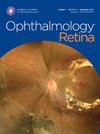Reverse Pupillary Block after Implantation of a Sutureless Scleral Fixation Carlevale Intraocular Lens
IF 4.4
Q1 OPHTHALMOLOGY
引用次数: 0
Abstract
Purpose
To describe the incidence, complications and management of reverse pupillary block (RPB) after implantation of Carlevale intraocular lens (IOL).
Design
Multicenter, retrospective, cross-sectional study.
Participants
Of a sample of 128 patients that had undergone Carlevale IOL implantation, 19 patients were found to present RPB.
Methods
Nineteen patients with RPB after Carlevale IOL implantation were evaluated and treated with laser peripheral iridotomy (LPI).
Main Outcome Measures
Demographic data (age and gender), data on preexisting medication, axial length (Zeiss IOLMaster 500 and Zeiss IOLMaster 700), presence of pseudoexfoliation material, presence of RPB (anterior segment swept-source SS-OCT Anterion, Heidelberg Engineering), presence of macular edema (Irvine Gass syndrome, OCT Spectralis, Heidelberg Engineering), anterior chamber depth (ACD) before and after LPI, best-corrected visual acuity (BCVA) before and after LPI, and intraocular pressure (IOP) before and after LPI were analyzed.
Results
An incidence of RPB of 14.8% was found. The prevalence of pseudoexfoliation syndrome was 21.1%, and 42.1% of patients presented an axial length >24.00 mm. Mean pre-LPI ACD was 4.78 ± 0.465 mm and post-LPI ACD was 4.23 ± 0.404 mm, a statistically significant increase of 0.54 mm (P < 0.001; 95% confidence interval, 0.26–0.83) of ACD was observed. There were no differences between pre- and post-LPI BCVA. Pre-LPI IOP was 17.10 (range, 12–34) mmHg and post-LPI IOP was 14.47 (range, 10–21) mmHg, (P = 0.391). Cystic macular edema (Irvine Gass) was identified in 4 of 19 patients, reporting an incidence of 21.1% in RPB cases.
Conclusions
Reverse pupillary block is a relatively common complication after Carlevale lens implantation, which may be associated with an increase of macular edema incidence but does not clearly correlate an increase of IOP. Our hypothesis is that indentation of the sclera induces a posterior rotation of the peripheral iris, causing RPB. Our results encourage looking over the Carlevale IOL implantation technique to consider a routinely intraoperative surgical peripheral iridotomy to avoid RPB and its further complications.
Financial Disclosure(s)
The authors have no proprietary or commercial interest in any materials discussed in this article.
植入无缝线巩膜固定(SFF)人工晶体(Carlevale,Soleko)后出现瞳孔反向阻滞。
目的: 描述植入卡列韦勒人工晶体后瞳孔反向阻滞(RPB)的发生率、并发症和处理方法:多中心、回顾性、横断面研究:在128名接受卡氏人工晶体植入术的患者样本中,发现19名患者出现RPB:方法:对 19 例卡氏人工晶体植入术后出现 RPB 的患者进行评估,并采用激光周边虹膜切开术(LPI)进行治疗:人口统计学数据(年龄、性别)、既往用药数据、轴向长度(蔡司 IOLMaster 500 和蔡司 IOLMaster 700)、是否存在假性角膜剥脱材料(PXF)、是否存在反向瞳孔阻滞(海德堡工程公司前段扫源 SS-OCT Anterion)、黄斑水肿(Irvine Gass 综合征,OCT Spectralis,海德堡工程公司)、LPI 前后的前房深度(ACD)、LPI 前后的最佳矫正视力(BCVA)以及 LPI 前后的眼压(IOP)。结果显示RPB发生率为14.8%。假性角膜外翻综合征的发病率为 21.1%,42.1% 的患者眼轴长度大于 24.00 毫米。LPI 前的平均 ACD 为 4.78 ± 0.465 mm,LPI 后为 4.23 ± 0.404 mm,ACD 在统计学上显著增加了 0.54 mm(P=0.000,IC 95% 0.26-0.83)。LPI 前后的 BCVA 没有差异。LPI 前眼压为 17.10(范围 12-34)mmHg,LPI 后眼压为 14.47(范围 10-21)mmHg,(p= 0.391)。19例患者中有4例出现囊性黄斑水肿(Irvine Gass),RPB病例的发病率为21.1%:结论:瞳孔反向阻滞是卡氏晶状体植入术后一种相对常见的并发症,可能与黄斑水肿发生率的增加有关,但与眼压的升高并无明显关联。我们的假设是,巩膜的压痕诱发周边虹膜后旋,从而导致 RPB。我们的研究结果促使我们重新审视卡氏人工晶体植入技术,考虑在术中常规进行周边虹膜切开术,以避免 RPB 及其并发症。
本文章由计算机程序翻译,如有差异,请以英文原文为准。
求助全文
约1分钟内获得全文
求助全文

 求助内容:
求助内容: 应助结果提醒方式:
应助结果提醒方式:


